|
Crane (Grus grus)
(aka Eurasian or Common Crane) |
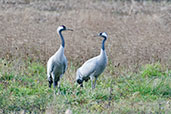 |
Lac du Der-Chantcoq, France
November 2002
The Crane breeds from Scandinavia and northern Germany across eastern Europe and into Asia. It winters in France and the
Iberian Peninsula, northern and eastern Africa, the Middle East, northern India and China.
|
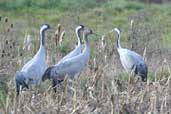 |
It breeds in shallow wetlands including forested swamps and bogs while in winter it feeds in open country such as
grassland or on cultivated land. It tends to roost overnight in large flocks in shallow wetlands.
The Lac du Der-Chantcoq is one of its traditional wintering areas and there were thousands of birds there when I visited in
November 2002.
|
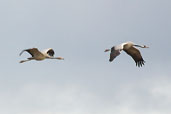 |
It is a very large bird with long legs and a long, thin neck. mostly pale bluish-grey in colour. The head and
upper neck are black and white with a batch of red bare skin on the back of the crown (not readily visible in these photos).
The juveniles have a rather pale grey-brown head and neck as can be seen with adults in photos 2, 3 and 4.
|
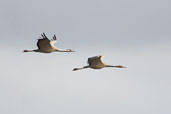 |
They migrate in large flocks of up to 300 birds and, in
their winter quarters also forage in similar sized flocks. It is a magnificent sight (and sound) to watch these flocks return to the evening roost in
wave after wave for several hours until there are thousands of birds at the roost. At dawn the flocks disperse again to forage up to 20 or so
kilometres away. |
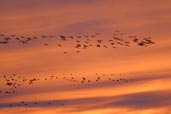 |
Food consists mainly of plant material such as roots,
tubers, leaves, seeds and fruits but insects and earthworms are also eaten. Vertebrate prey includes frogs, lizards and snakes while fish are less
commonly eaten. |
|
|




